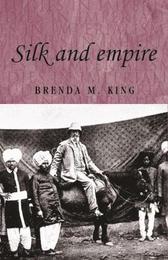
|
Silk and Empire
Paperback / softback
Main Details
| Title |
Silk and Empire
|
| Authors and Contributors |
By (author) Brenda King
|
| Series | Studies in Imperialism |
|---|
| Physical Properties |
| Format:Paperback / softback | | Pages:224 | | Dimensions(mm): Height 234,Width 156 |
|
| Category/Genre | British and Irish History
Asian and Middle Eastern history
Colonialism and imperialism |
|---|
| ISBN/Barcode |
9780719067013
|
| Classifications | Dewey:338.4767739094109034 |
|---|
| Audience | | Tertiary Education (US: College) | | Undergraduate | | Postgraduate, Research & Scholarly | |
|---|
| Illustrations |
Illustrations, colour
|
|
Publishing Details |
| Publisher |
Manchester University Press
|
| Imprint |
Manchester University Press
|
| Publication Date |
9 December 2008 |
| Publication Country |
United Kingdom
|
Description
In this book, Brenda M. King challenges the notion that Britain always exploited its empire. Creativity, innovation and entrepreneurship were all part of the Anglo-Indian silk trade and were nurtured in the era of empire through mutually beneficial collaboration. The trade operated within and without the empire, according to its own dictates and prospered in the face of increasing competition from China and Japan. King presents a new picture of the trade, where the strong links between Indian designs, the English silk industry and prominent members of the English the arts and crafts movement led to the production of beautiful and luxurious textiles. Lavishly illustrated, this book will be of interest to those interested in the relationship between the British Empire and the Indian subcontinent, as well as by historians of textiles and fashion. -- .
Author Biography
Brenda M. King is Lecturer in Design History and Museum and Heritage Studies, an Independent Researcher and an exhibition Curator.
Reviews""Silk and Empire" contains information of central importance to a fuller understanding of a diverse range of topics, from Arts and Crafts movement generally and William Morris in particular, to the creation and impact of the Great and International Exhibitions from 1851 onwards, as well as the origins and functions of significant collections of Indian skills now held in the UK. All with an interest in these topics - and in the history of British textile consumption, design and education - will want to read this book." --Mary Schoeser, "Crafts"
|